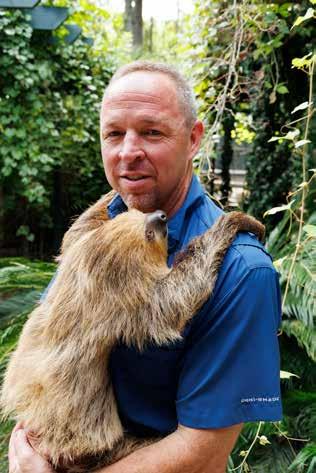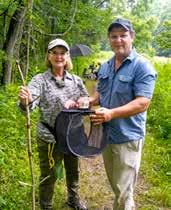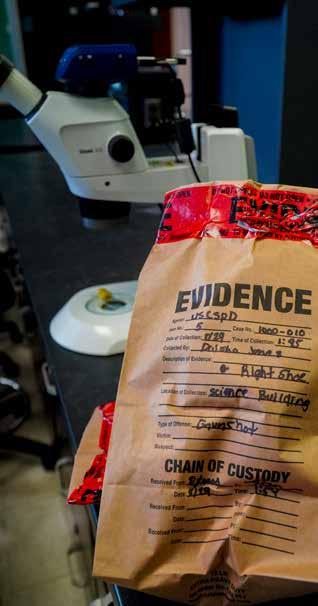Creature Comforts
The origins of the Bee City Zoo

FORENSIC ANALYSIS PLAY BALL!



FORENSIC ANALYSIS PLAY BALL!

By Shirley Bloomfield, CEO NTCA–The Rural Broadband Association
NTCA members create broadband networks so fast and reliable that it’s easy to take for granted the effort and expertise needed to bring these services to homes and businesses. These professionals do amazing work, particularly when considering the intricate, multistep journey to build, expand and maintain a network.
It begins with detailed research and careful planning. The broadband provider must learn exactly how many homes and businesses might want service, as well as the challenges posed by the landscape. Then, a thorough review of the numbers determines if the project makes financial sense. It’s a puzzle where the pieces are population density, infrastructure costs and potential demand for the service.
Then there’s the engineering—design, build and inspect. Detailed maps identify routes for cables, permitting, environmental regulations and access to land. Some of these projects can take two to four years from the first engineering drawing to the first connection.
The work doesn’t stop when the network goes live. These networks require maintenance, technology upgrades and customer support.
These networks are lifelines connecting rural communities to telehealth, education, remote work and cutting-edge technologies. With the help of service providers like yours, we’re building broadband to last and ensuring no community gets left behind in our increasingly digital world.
To learn more, check out the Foundation for Rural Service and JSI’s latest report, “Delivering Broadband From Beginning to ‘End,’” at frs.org/deliveringbroadband-beginning-end.

When you need information fast, a quick check of Google is often the first stop. In fact, some people find it easier to search online for everything, including the addresses for a specific website like a bank, trusted repair service or health care provider.
Unfortunately, scammers know this, too, so they sometimes create bogus sites with addresses confusingly close to the real thing.
Google is aware of this trend, and it touts advanced systems that keep users’ search results 99% spam-free. The company also offers a few tips for closing the final security weaknesses.
• Pay close attention to the URL—the specific web address—before clicking any unfamiliar link. Typically, in an email, hovering the cursor over the address will show the complete link. Don’t click the link if it looks suspicious.
• The three dots next to the search results in Google can be used to find more details about the webpage, store or business you’re considering. You can find clues indicating if the site is legitimate before clicking the link.
• When you’re looking for official resources, watch out for unusual address formatting. For example, there’s typically only one correct customer service number for a larger company. But not all businesses have customer service numbers, and searching for them requires you to be mindful. Watch for strange formatting in the website address, including unexpected symbols or emojis.

Story by BRANDI DIXON
Hannah Dasher is a blast of classic country and rock ’n’ roll paired with social media influencer. Stepping into the home she calls “Honky-Tonk Graceland” and features on her social media is, as Hannah says, like going back in time to “your meemaw’s house.”
“Avocado green canisters, gold salt and pepper shakers, brass pots. I love my retro kitchen, and I love that the fans feel right at home,” she says, adding that she enjoys entertaining.
Music and songwriting are Hannah’s first loves. “I was rehearsing my acceptance speech for best new female vocalist of the year in my mirror at age 10,” she says. “I grew up listening to ’90s country radio, and knew I wanted to be an entertainer.”
Hannah pursued music professionally, taking her big hair and a heaping helping of Southern charm to Nashville, Tennessee. She started out writing songs for other artists, getting some big accolades thanks to collaborations with Brad
Paisley, Lainey Wilson and Ian Munsick, to name a few. She continued performing whenever she had the chance.
In 2020 during the pandemic, Hannah found herself stuck. “All the stages shut down, and I needed a stage,” she says. “Talking with some friends I learned a lot of girls my age couldn’t cook, so I stumbled into the world of social media, and it was the perfect storm.”
Hannah took to TikTok to share her
family’s beloved recipes and a few of her own, all while sprinkling in a bit of her signature rockin’ country flavor. The recipe produced the now-viral Stand By Your Pan social media accounts. More than 1.5 million followers join Hannah daily in her retro kitchen.
“I love that this brought country and noncountry music fans together,” she says. “It’s hard to pigeonhole into just one world, and I’m glad that I can be this representative of the past and the future via a semicelebrity chef.”
When Hannah Dasher isn’t cranking out content, she’s picking up a guitar and writing music.
“God always sends it from the left side of the sky and out of my mouth,” she says of her process. “Sometimes it’s melody and lyrics simultaneously, but you just never know, and you always have to be looking for it.”
Hannah is on the road this year with her band on The Wanted Tour, featuring stops across the United States, the United Kingdom and Sweden. She encourages fans to spread the word and come see her and her “boys.”
There’s something magical when technology becomes so advanced that it simply works, without muss, fuss or the need for advanced skills. Your smartphone is a great example, particularly whatever app you prefer for photos. Looking for an image of your cat or dog, a mountain or a beach? Just ask and the search will likely provide shockingly good results.

JASON DANDRIDGE Chief Executive Officer
That app simply does the job, and our internet service is much the same—it simply works. It’s fast, reliable and resilient. Thanks to the long-term investments to create a fiber optic network supported by a team of local professionals, we can provide services that unlock the online world. If you consider internet access essential, there’s no better option.
Whether you’re working from home, attending virtual classes or binge-watching your favorite shows, fiber makes sure everything runs smoothly. Do you have multiple devices online at once, rely on video calls or enjoy challenging online games? No problem. The performance is there whenever you need it.
It’s important to remember, not all technologies have the same benefit. They may work, but not as well as fiber. With those other systems, storms might block signals or otherwise create interruptions. However, compared with other technologies, our fiber network is designed to not only stay online more reliably but also bounce back more quickly if there is an outage.
Not every community gets to enjoy this type of internet service. We designed our fiber network for today with features capable of handling future online tools and resources. Considering how quickly technology is advancing, an adaptable network is vital for our community to stay competitive in an increasingly online world.
After all, high-speed internet is more than a nice-to-have luxury. From telehealth services to online education, fiber optic networks give us access to essential resources that fundamentally improve our quality of life. Similarly, reliable, fast internet energizes our economy. From established area businesses to new entrepreneurs, the internet provides the tools needed to compete.
We’re committed to bringing these benefits to every corner of our community. And please remember, Palmetto Rural Telephone Cooperative is about more than the physical network. The dedicated professionals making up our team live here, believe in our area’s future and are committed to providing unparalleled support.
So, let’s celebrate the progress we’ve made and look forward to a future where everyone can enjoy the advantages of cutting-edge technology. Our goal is to ensure no one is left behind and that everyone has access to the opportunities high-speed internet provides.
Thank you for your continued support and trust. Together, we’re building a brighter, more connected future.
PRTC Connection is a bimonthly magazine published by PRTC, © 2025. It is distributed without charge to all member/owners of the cooperative.
is a member-owned cooperative providing a complete telecommunications solution (internet, video, voice, wireless and security) to the homes and businesses in the Lowcountry of South Carolina.
Send address corrections to: PRTC
P.O. Drawer 1577
Walterboro, SC 29488 Telephone: 843-538-2020 prtc.us
For information about the content included in PRTC Connection, please contact Sean Gruber, Public Relations and Marketing Coordinator, at 843-538-9330.
BOARD OF DIRECTORS
District 1 - Brian Ackerman
District 2 - Cynthia “Cindy” Colson
District 3 - Kenny Blakeney
District 4 - Liza Catterton
District 5 - Gloria Warren
District 6 - Travis Avant
District 7 - Heath Griffith
Produced for PRTC by:
On the Cover:

Diane and Archie Biering started Bee City Zoo with just beehives, growing it into a zoo with many animals, including lemurs. See story Page 8.
Charleston County SC Connect CPF/ARPA
3.0 Grant—The Cherry Hill and New Road areas are ready. Construction is ongoing east and west of the town of Hollywood.
Bamberg County SC Connect CPF/ARPA 3.0 Grant—Construction and splicing are complete in and around Deacon Road. Construction is ongoing south and north of Highway 78 and east of the town of Bamberg.
Hampton/Colleton/Jasper Counties SC CPF/ARPA 3.0 Grants—Construction continues in the Point South and Yemassee areas. Staking started in Hampton and Varnville. Design is ongoing for the Coosawhatchie and Morgan Dollar areas with construction starting in July.


Q. What is your title with PRTC, and how would you explain your responsibilities?
A. I am the payroll accountant. My main responsibility is processing payroll and reporting required payroll documents along with other accounting responsibilities like reconciling an assortment of accounts.
Q. When did you start working at PRTC?
family or at church functions, I love to be outside, playing with the dogs, cutting grass in the summer, getting wood for the winter or working on other projects. My all-time favorite is going out on the boat and spending the day on the water!
Q. How has broadband access helped you or your family?
MEMORIAL DAY
PRTC’S OFFICES WILL BE CLOSED ON MONDAY, MAY 26, IN OBSERVANCE OF MEMORIAL DAY. TAKE TIME TO RECOGNIZE AND REMEMBER THE MEN AND WOMEN WHO GAVE THEIR LIVES WHILE SERVING IN THE U.S. MILITARY SO WE CAN CONTINUE TO LIVE IN FREEDOM.
A. I started with PRTC on March 1, 2022.
Q. What do you enjoy about your current position?
A. Everything! This is a fast-paced position, so it keeps me busy. PRTC is like one big family, and I am so blessed to be a part of this establishment.
Q: Tell us about your family.
A: I have been married to David Jackson for 26 years. He is employed with Coastal Electric Cooperative and preaches at Pleasant Grove Baptist Church. We have two children. Nicholas is 23, and Haley is 20. We have four additional “animal children,” two Labs, Autumn and Chance, and two cats, Speckles and Marble.
Q: What do you like to do in your spare time? Any local hobbies, volunteering or civic groups?
A: When I am not spending time with
A. Broadband has helped our family by being able to communicate with each other via Facetime, computers, etc. We also use it for TV access or casting videos at our family functions.
Q: Since we’re a tech company, are there any apps that you use often or help with your personal daily routine?
A: Yes, I use Blink, Bitwarden, Life360, Instagram, etc.
Q: What are your favorite movies, modern or classic series?
A: I would have to say my favorite movies are “Fast & Furious” and “Rush Hour.”
Q: What is your favorite aspect of our community?
A: Walterboro and the surrounding community have the most beautiful scenery anywhere. Within a short drive, we can be on the beach, lake, river or the Smoky Mountain foothills. Location is everything!


Story by JOHN CLAYTON
Ric Sisler admits he misses the annual spring-to-fall marathon of a baseball season. “When it’s in your blood, it doesn’t matter what you’re doing. You’re always going to be pulled toward that industry, and I’m
WHAT’S IN A NAME?
certainly no exception,” he says. “Going to the ballpark, the camaraderie and being around the yard was just a thrill for me.
“I certainly don’t miss tarp pulls and some of those types of things,”
Marketers and merchandisers will say quite a lot. Creative—some may say outlandish—nicknames, mascots and logos are part of the landscape of minor league baseball. Here are a few of our favorites:
Florida: The Fort Myers Mighty Mussels—The nickname is more about seafood than sinew.
Alabama: Rocket City Trash Pandas—It pairs Huntsville’s role in the space industry with a cute raccoon reference.
Georgia: Augusta GreenJackets—The GreenJackets mascot is
Road trip to baseball’s most entertaining destinations
he says with a laugh, referring to the back-breaking work of getting protective tarps on and off the diamond during rainy weather.
The national pastime is most certainly in Ric’s blood. He played for three
akin to a yellow jacket, but the reference is to Augusta’s long history with The Masters golf tournament, which awards the winner a green jacket.
North Carolina: Kannapolis Cannon Ballers—The alliteration is nice for the team once known as the Intimidators after the late NASCAR star and Kannapolis native Dale Earnhardt Sr., who was then part-owner of the team. The Cannon Ballers mascot, Boomer, has an uncanny resemblance to Earnhardt.
Kentucky: Bowling Green Hot Rods—The nickname gives the team a link to the nearby National Corvette Museum.

seasons in the New York Yankees minor league system before running several minor league organizations as a front office executive and as vice president/ general manager of the independent South Coast League based in Georgia. His father, Dick Sisler, was a Major League Baseball manager and All-Star player, and his grandfather, George Sisler, is enshrined in the National Baseball Hall of Fame.
Ric, who is still involved in athletics as director of corporate sponsorships at Western Carolina University, says many fans of the game come back season after season.
“Minor league baseball has been part of the fabric of our society in a lot of smaller towns,” he says. “It was kind of a binding agent for folks to come watch baseball with their friends and neighbors and just have a wholesome time.”
While the minor leagues are about family fun and community pride to many fans, the game is a balance of business and player development for the teams and their MLB affiliates. The minors have long relied on fan-friendly, creative promotions and player interactions to sell tickets, and all of that comes with an affordable price tag.
“I think people have always gone to minor league games because it’s
affordable,” Ric says. “You had great entertainment and could see some potential big-league players there at

an affordable price. You’re very close to the field and close to the players. It was a different setting from the Major League parks. I don’t want to see that change.”
Planning a trip this summer––or maybe even a baseball pilgrimage? There’s a game, sports history and tradition, as well as a bunch of fun waiting for you.
Some of the oldest ballparks in the country are in the Southeast, and three of them are on the National Register of Historic Places.
That list includes Birmingham, Alabama’s Rickwood Field, which is the nation’s oldest professional baseball park still with its original structure. Opened in 1910, two years before Boston’s Fenway Park, Rickwood was home to the Negro Leagues’ Birmingham Black Barons.
The double-A Birmingham Barons play an annual ceremonial game at Rickwood, and Major League Baseball hosted a game between the St. Louis Cardinals and San Francisco Giants at the venerable ballpark last season, a 6-5 Cardinals victory.
Jackie Robinson Ballpark in Daytona Beach, Florida, was the first ballpark to allow the Brooklyn Dodgers’ African American prospect whose name now graces the stadium to play with white players in the segregated South in 1946. The park dates to 1914 and was originally named Daytona City Island Ballpark.
Spartanburg, South Carolina’s Duncan Park was constructed in 1926 and was home to minor league baseball almost continually until 1994. It was also home to the Spartanburg Sluggers, a Negro League minors team from 1928-52. An estimated 21,000 spectators reportedly crowded in and around the ballpark to attend Game 5 of the 1938 American Legion World Series between Spartanburg and Los Angeles.
The 3,000-seat stadium is currently Spartanburg High School’s home field. The city of Spartanburg is building a new stadium for the Hub City Spartanburgers of the South Atlantic League. The city is the new home of the former Down East Wood Ducks of Kinston, North Carolina.
Story by JUDITH GARRISON
It was a hobby that got out of hand.
When Diane and Archie Biering retired from their blue-collar, 9-to-5 jobs, they started playing with beehives.
“It was as if he had lost his mind,” says their son, Scott Biering.
Archie painted 60 beehive boxes to look like city buildings. He had a Piggy Wiggly, a Baptist church, an Applebee’s and a BP station—complete with tar paper roads and street signs. The posted speed limit was 5 mph, the average speed of a honeybee.


When people started noticing the unusual city, they began visiting. With the addition of animals as an extra draw, Bee City Zoo was born.
In 2011, Scott lived 25 minutes from his parents’ home, but he’d only seen them four times in the previous year, a realization that changed his future.
At the time, Scott worked as a UPS driver, following stints in the military, dock building and steel production. His history of working hard, a concept fueled by his parents, led him to make an offer
to buy the family business. However, the business wasn’t what he wanted most—he wanted time with his mom and dad.
“I’m going to hate myself if I don’t change my lifestyle and get to know them as adults,” Scott recalls telling his wife, Bridgett, who wasn’t initially onboard with the idea.
But, after not sleeping all night, the next morning Bridgett told her husband to make his parents an offer, saying they’d do whatever they had to do to make it work. Eight months later, Scott and Bridgett sold their house in Summerville and built a little homestead on the Bee City Zoo land.




After the purchase went through, Scott spent time with his father, learning as much as possible about the animals as well as the honey enterprise, a separate business model.
“I started with four employees,” Scott says, the same number as his father had. He continued to buy surrounding land as it became available. Today, the Bee City Zoo
has about 60 employees, a footprint of nearly 20 acres and many retailers selling its honey.
With department heads plus a supervising staff, Scott spends his time imagining concepts and new avenues to explore. His plans include on-site Airbnb rentals including animal experiences.
Growing up in the 1950s and 1960s, Diane and Archie knew what it meant to work hard. And when retirement rolled around, operating this business successfully was no different. They took courses with the South Carolina Beekeepers Association, learning more about their honey producers. In time, their small collection of animals morphed into a rescue operation for exotic animals that needed a home. One of the first creatures they took in was Spanky, a monkey whose family couldn’t handle him anymore.
Over time, the zoo grew from simply caring for a few animals to providing an environment suitable for the animals’ needs. Buildings were constructed specifically to care for each animal that arrived, and Scott promised to provide whatever enclosure or habitat was needed.
Over the years, the animal count soared from its original 60 to over 400. Giraffes,
tigers, kangaroos, zebras—even a cassowary, a prehistoric-looking bird from New Guinea. “It looks like the closest thing on Earth to a dinosaur and very few zoos have them,” Scott says.
Working with a network of private zoos, Bee City Zoo continues to be a resource for animal care and rescue. “We’d love to see them in the wild,” Scott says. However, the only place for many of these animals to survive is in captivity. Scott says that most of the animals in zoos today are the fourth generation born into captivity. Zoos are where they can flourish.
When visitors arrive at Bee City Zoo, the staff educates them about the animals, sharing that less than 15% of the world’s creatures that have ever existed remain alive today.
Scott credits the zoo’s exponential growth and wide appeal to electronic and digital sources. Without broadband capabilities, he says, you’re pretty much out of the game. Although his parents didn’t share his viewpoint. “My dad’s big thing, up until the very end was ‘You don’t need that internet. It’s all word of mouth,’” Scotts says.
While Scott agrees with his dad about the value of a positive reputation, he recognizes that social media is a powerful force. “Facebook is word-of-mouth on steroids,” he laughs. And now, with many of the zoo’s patrons choosing other platforms like Instagram and TikTok, that’s exactly where you’ll find Bee City Zoo.
1066 Holly Ridge Lane, Cottageville 843-835-5912
beecityzoo.com
Find Bee City Zoo on Facebook, Instagram and TikTok.

Story by SARA DIAMOND PATTERSON
Catching lightning bugs in a Mason jar with holes punched in the lid is a summer ritual for kids across the country. Watching their light show together is often a time for families to slow down, which is what Lynn Frierson Faust’s family began doing in the Great Smoky Mountains during the 1960s.
They marveled for years at the unique light display, as the flying beetles blinked on and off at the same time for several hours after dark. When Lynn heard the August 1991 edition of Science News magazine featured an article on fireflies that blink in unison, she figured she would finally find out why and how they made their magic.
“I remember thinking, ‘Oh cool, a lightning bug feature. It’ll talk about our light show.’ Only it didn’t mention one thing,” she says. In fact,
the authors said the Western Hemisphere had no species of fireflies that blinked synchronously.
Lynn let them know they were mistaken and invited them to come to the Smokies to see the show for themselves. The scientists did and agreed Lynn was right, lighting the way for her life’s work.
‘JUST SO DARN FUN’
As “The Lightning Bug Lady,” Lynn is internationally known for her research on the ecology and habits of the more than 125 species of U.S. fireflies, helping
HOW: Fireflies produce their magical flashes through bioluminescence, a chemical reaction.
WHY: Each of the more than 125 species of fireflies in the United States—2,000 worldwide—has a unique signature flash pattern the males use to attract females of their specific type.
WHERE: Everywhere. Many Western species do not flash or fly, but they’re out there.
WHEN: Warm summer nights.

Pesticides and habitat reduction have taken a toll on firefly populations. Maintaining a “wild” area of your yard with a little water, native vegetation and undisturbed soil will make your home more firefly friendly. But the easiest way to help is simply by turning out the lights during their active period. Visit xerces.org or firefly.org for more tips.


A BBC crew takes a break from filming in 2019. Naturalist Lynn Frierson Faust examines equipment she and Mark Zloba, ecological manager at the Edge of Appalachia, use to gather fireflies at the preserve outside of Cincinnati.
to raise awareness of their unique life cycles and importance within ecosystems.
She scrambles to 14 states each year to catch them emerging during their eight-week active season, usually early June to late July. For 18 years, she has been the worldwide go-to on the subject, serving as on-site scientific consultant for BBC Earth, Discovery, National Geographic and other international film crews. Lynn’s 2017 book, “Fireflies, Glow-worms, and Lightning Bugs,” was the first-ever comprehensive firefly field guide and shared the results of her nearly three decades of research on behalf of museums, universities, state and national parks and nature centers.
“I’m not a scientist per se, but I’ve done the research, a whole lot of research,” she says. “I’m just a regular person obsessed with these and fortunate to have the time and a little knowledge to build on.”
Throughout history, fireflies have symbolized hope and mystery, serving as transient reminders that life is fleeting. In some cultures, people see them as their lost ancestors, a sacred connection between the earthly and spiritual worlds.
When she began, Lynn didn’t have much research to start with. “There were just a bunch of dusty old scientific papers, but that’s about it,” she says. “There’s just not been that much research done on them since they aren’t harmful or helpful to people or crops.”
They are, however, a great indicator species for the health of ecosystems. “When they disappear, we have to know why and where to look.” And
No matter where you are, you don’t have to go far to find the magic. You can look for lightning bugs anywhere from your backyard to wildlife management areas or wooded parks, avoiding light pollution and areas that spray for mosquitos.
The Southeast offers the most variety of firefly species. “Generally speaking—and this holds true for almost all living things—as you go south closer toward the equator, you get a greater diversity of species but maybe fewer numbers,” firefly expert Lynn Frierson Faust says. “Whereas when you go north in latitude, you get greater numbers but fewer species.”
The Photinus carolinus species in the Great Smoky Mountains National Park of Tennessee and North Carolina are known for their synchronous flashes. You can see them put on a similar show at South Carolina’s Congaree National Park. Thousands of these fireflies emit between five to eight flashes of light all at once followed by eight to 10 seconds of darkness.
Their light shows have become so popular, each year more than 20,000 people enter a lottery drawing at each park for viewing spots during the two-week active period, usually in early June depending on temperatures and soil moisture.
Lynn says they will always serve as a nostalgic reminder of days gone by.
“Lightning bugs are fantastic ambassadors leading people back into nature and to a better understanding of the connectedness of it all,” she says. “Plus, they’re just so darn fun.”
Officially known as Lampyridae, worldwide fireflies are called blinkies, glowflies, moon bugs, peeneywallies, blinkin’ bees, hoturu, fire beetles and candle flies. Here at home, “lightning bug” is more common in the South and Midwest, while “firefly” is typically heard in the West and large cities in the East. Some researchers attribute the differences to weather. While lightning is most active in the South and Midwest, the West sees the most wildfires.

STORY BY JUDITH GARRISON
Earlier this year, the University of South Carolina Salkehatchie opened a new forensic science lab at the Allendale campus. “This lab represents a significant milestone for our criminal justice program,” says Francis Burns, the assistant professor of chemistry who initially proposed the lab.
Burns, along with senior criminal justice instructor, John Peek, created a plan to secure funding, write the course of study and outfit the lab.
Providing hands-on experience in fingerprinting, drug testing, DNA analysis and other skills necessary in the processing of crime scenes, the new state-ofthe-art forensics lab is the culmination of years of planning.
As more students graduate from this two-year program, they will fill a critical void to help clear backlogged cases and provide scientific evidence to aid in criminal prosecutions.
Although students are not working active cases, they are learning from local agencies and law enforcement officials about crime solving through lectures and field trips. The South Carolina Law Enforcement Division plays a vital role in helping students understand the precise and objective analysis of data.
Providence Colucci, a criminal justice
major, is learning the precision and conviction it takes to work in the field. Every sliver of evidence counts, and as she begins her career in forensics, the victim’s voice is her inspiration.
“I am delivering the verifiable truth,” Colucci says. “Justice is allowed to take place.” She recognizes many people are impacted by a crime, not just those directly involved in the incident. The friends, families and especially the children of the victim and the accused are collateral damage. For Colucci, providing those affected with a proper outcome is critical.
As others follow the forensic path, the USC Salkehatchie’s new forensic lab will provide the education to fill a growing need.
Thinking in reverse order is not a natural process for most people, but that’s exactly what must happen in forensics. Those who examine DNA, fingerprints and other evidence must train their minds to think logically and then move backward.
Suppose you are going to become an expert in shoeprint analysis. First, you learn about shoes, their materials and functions. You learn about the processes involved in wearing down soles and making shoeprints. You also have to learn

about basic forensics and documenting shoeprints. You start working backward by looking at the shoeprints left at the scene and try to figure out which shoes made those prints.
The goal of forensic science is to gather the evidence and then hand it off


Sometimes a convicted felon may become a suspect because his or her DNA appears at a crime scene, and then investigators find that individual’s DNA in the database.
“Technology is a critical ‘lubricant’ in forensics,” Burns says. It removes innocent people from investigation and allows investigators to focus on fewer suspects, ultimately closing cases.
Burns is excited for graduates of the forensics program. With extensive opportunities in the field, plus with the introduction of artificial intelligence into the equation, investigations will become faster and more accurate. As forensic analysis enters the 21st century, its future will only be as productive as the scientists, like Colucci, who are ready to make the world a better place.
For those who are unjustly accused, forensics should help to eliminate fear and uncertainty. For the guilty, scientific evidence provides a swift resolution.
“It is important to give people voices in my work,” Colucci says, “to bring proper justice to victims and provide more support to the families who are involved.” And with trained scientists, proper judgment can be achieved for every person directly or indirectly impacted by a crime.
to officials to determine a person’s guilt or innocence. It’s not a crystal ball, but as long as credibility is maintained, it’s the best weapon for law enforcement to close new, as well as cold, cases.
Speed is a priority in forensics. Broadband connects results and databases to law enforcement agencies in record time, eliminating suspects and targeting the true evidence.
According to Burns, every forensic lab has at least one server linking it to the rest of the world while maintaining the chain of custody, which is critical. Criminal investigators and legal professionals both use the databases.
One such database is the Combined DNA Index System. Also known as CODIS, this database compiles DNA results from crime scenes, charged suspects and convicted felons. Even shoeprints have databases, such as Solemate.


Many say munching on piping-hot, crispy fried chicken is a joy like no other. Whether it’s juicy white meat from the breast or the wings or the deep, engaging flavors of the dark meat found in thighs and legs, when it comes to fried chicken, most everyone has a preference. But there are a few things that good pieces of fried chicken have in common—the skin must stay on, and it must be crispy.
That’s not too much to ask, but it’s something that many cooks cannot achieve. There’s a knack to it that may take a few extra steps, but the endgame is well worth it.
Serve the chicken alongside a big spoonful of potato salad and finish with a bowl of banana pudding and you have a meal fit for a beautiful summer evening.

Food Editor Anne P.
Braly
is a native of Chattanooga, Tennessee.
Photography by Mark Gilliland
1 (4-pound) chicken, cut into pieces
1 cup whole milk buttermilk
2 cups all-purpose flour for coating
1 teaspoon paprika
1 teaspoon garlic powder
Salt and pepper to taste
2 quarts vegetable oil for frying
Dry chicken with paper towels. Put the flour in a large plastic bag. Let the amount of chicken you are cooking dictate the amount of flour you use. Season the flour with paprika, garlic powder, salt and pepper to taste. Paprika helps to brown the chicken.
Dip chicken pieces in buttermilk then, a few at a time, put them in the bag with the flour, seal the bag and shake to coat well.
Place the coated chicken on a cookie sheet or tray, and cover with a clean dish
towel or waxed paper. Let sit until the flour reaches a paste-like consistency. This step is important to ensure that the skin will be crispy and adhere to the chicken.
Fill a large skillet (cast iron is best) about 1/3 to 1/2 full of vegetable oil. Heat until very hot.
Put in as many chicken pieces as the skillet can hold. Brown the chicken in hot oil on both sides.
When browned, reduce heat and cover the skillet. Let cook for 30 minutes (the chicken will be cooked through but not crispy). Remove cover, raise heat again and continue to fry until crispy. Drain the fried chicken on paper towels. Depending on how much chicken you have, you may have to fry it in a few batches. Keep the finished chicken in a slightly warm oven while preparing the rest.

4 pounds russet potatoes
1-2 tablespoons olive oil
3 tablespoons apple cider vinegar
1 cup mayonnaise
3/4 cup sour cream or full-fat Greek yogurt
1/2 cup cheddar cheese
1 teaspoon kosher salt
1 teaspoon freshly ground black pepper
12 ounces bacon, cooked, cooled and chopped
6 green onions, whites and green parts, chopped
Preheat the oven to 400 F. Place cleaned potatoes on a baking sheet and pierce four to five times with a fork. Lightly coat with olive oil, sprinkle with kosher salt and cook for 50-60 minutes or until easily pierced with a cake tester or skewer. Remove from the oven and let cool for 5 minutes. When cool enough to
8 ounces softened cream cheese
1 (14-ounce) can sweetened condensed milk
2 (3.4-ounce) boxes instant vanilla pudding
2 3/4 cups cold milk

handle, peel the potatoes and cut into 1-inch chunks, discarding the potato skins. The potato flesh may crumble and get shaggy, and that’s OK—transfer it all to a large mixing bowl. While still warm, sprinkle the potatoes with the apple cider vinegar. Set aside for 15-30 minutes or until the potatoes are cooled.
Meanwhile, cook the bacon in a large skillet or in the oven, drain and let cool. Crumble into bite-size pieces.
In a small bowl, mix the mayonnaise and sour cream. Season with the kosher salt and pepper.
When the potatoes are cool, pour the mayonnaise mix over them with the crumbled bacon, green onion and cheddar cheese. Gently fold the ingredients together. Season with more salt and pepper to taste. Refrigerate for 3 hours up to overnight before serving. Store in the refrigerator for up to four days.
8 ounces whipped topping divided 1 (1-pound) package Nutter Butter or other peanut butter sandwich cookies
5-7 ripe bananas, sliced
In a large mixing bowl, beat the softened cream cheese until smooth. Add the condensed milk and mix until there are no lumps.
In a second bowl, mix the pudding mix and milk together until smooth. Pour the pudding into the cream cheese mixture and mix until completely combined. Fold in half of the whipped topping.
Line the bottom of a trifle dish with a layer of Nutter Butter cookies. Add a layer of banana slices on top of the cookies. Spread a layer of the pudding mixture evenly over the bananas. Repeat 1-3 times, depending on the size of your dish. Spread the remaining whipped topping on top of the pudding. Cover and chill for at least 4 hours but overnight is best.
Crush a few Nutter Butters on top of the whipped topping immediately before serving.
























